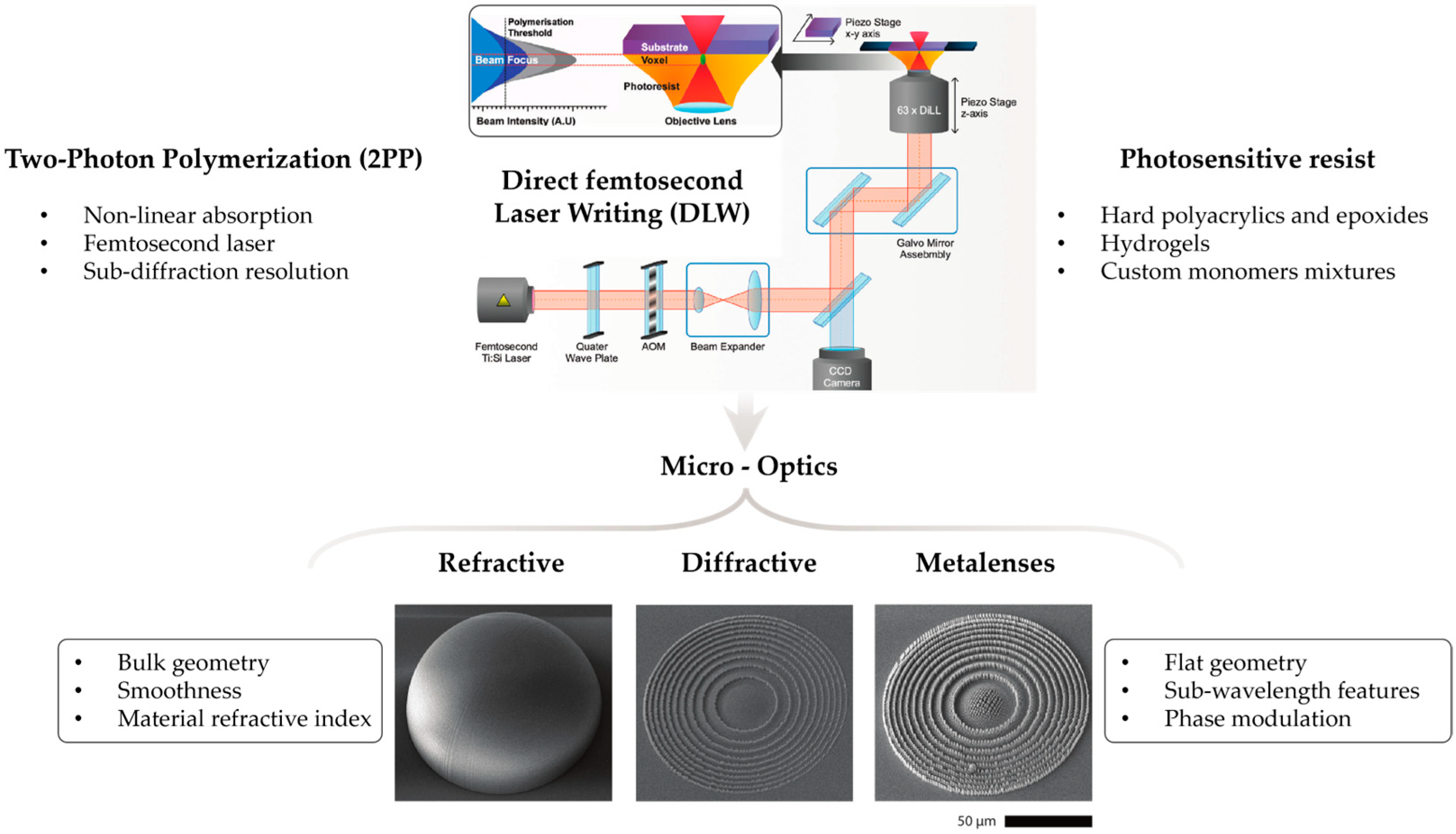Direct Femtosecond Laser Writing of Micro-Optical Components
Funding
Conflicts of Interest
References
- Maruo, S.; Nakamura, O.; Kawata, S. Three-dimensional microfabrication with two-photon-absorbed photopolymerization. Opt. Lett. 1997, 22, 132–134. [Google Scholar] [CrossRef]
- Kawata, S.; Tanaka, T.; Sun, H.-B. Finer features for functional microdevices. Nature 2001, 412, 697–698. [Google Scholar] [CrossRef]
- Emons, M.; Obata, K.; Binhammer, T.; Ovsianikov, A.; Chichkov, B.N.; Morgner, U. Two-photon polymerization technique with sub-50 nm resolution by sub-10 fs laser pulses References and links. Opt. Mater. Express 2012, 2, 942–947. [Google Scholar] [CrossRef]
- Malinauskas, M.; Farsari, M.; Piskarskas, A.; Juodkazis, S. Ultrafast laser nanostructuring of photopolymers: A decade of advances. Phys. Rep. 2013, 533, 1–31. [Google Scholar] [CrossRef]
- O’Halloran, S.; Pandit, A.; Heise, A.; Kellett, A.; Polymerization, T.-P. Materials, and Chemical Modification Strategies. Adv. Sci. 2023, 10, 2204072. [Google Scholar] [CrossRef]
- Wloka, T.; Gottschaldt, M.; Schubert, U.S. From Light to Structure: Photo Initiators for Radical Two-Photon Polymerization. Chem. Eur. J. 2022, 28, e202104191. [Google Scholar] [CrossRef]
- Wang, S.; Liu, Y. Recent Development of Lens Array Fabrication: A Review. J. Comb. Math. Comb. Comput. 2023, 118, 191–205. [Google Scholar] [CrossRef]
- Gonzalez-Hernandez, D.; Varapnickas, S.; Bertoncini, A.; Liberale, C.; Malinauskas, M. Micro-Optics 3D Printed via Multi-Photon Laser Lithography. Adv. Opt. Mater. 2023, 11, 2201701. [Google Scholar] [CrossRef]
- Siegle, L.; Ristok, S.; Giessen, H. Complex aspherical singlet and doublet microoptics by grayscale 3D printing. Opt. Express 2023, 31, 4179. [Google Scholar] [CrossRef]
- Tan, J.W.; Wang, G.; Li, Y.; Yu, Y.; Chen, Q.D. Femtosecond Laser Fabrication of Refractive/Diffractive Micro-Optical Components on Hard Brittle Materials. Laser Photonics Rev. 2023, 17, 2200692. [Google Scholar] [CrossRef]
- Schmid, M.; Thiele, S.; Herkommer, A.; Giessen, H. Adjustment-free two-sided 3D direct laser writing for aligned micro-optics on both substrate sides. Opt. Lett. 2023, 48, 131. [Google Scholar] [CrossRef]
- Gonzalez-Hernandez, D.; Sanchez-Padilla, B.; Gailevičius, D.; Thodika, S.C.; Juodkazis, S.; Brasselet, E.; Malinauskas, M. Single-Step 3D Printing of Micro-Optics with Adjustable Refractive Index by Ultrafast Laser Nanolithography. Adv. Opt. Mater. 2023, 11, 2300258. [Google Scholar] [CrossRef]
- Aslani, V.; Toulouse, A.; Schmid, M.; Giessen, H.; Haist, T.; Herkommer, A. 3D printing of colored micro-optics. Opt. Mater. Express 2023, 13, 1372. [Google Scholar] [CrossRef]
- Kariman, B.S.; Nardini, A.; Marini, M.; Roldán-Varona, P.; Conci, C.; Raimondi, M.T.; Osellame, R.; Cerullo, G.; Chirico, G.; Vázquez, R.M. High dioptric power micro-lenses fabricated by two-photon polymerization. Opt. Express 2024, 32, 48114. [Google Scholar] [CrossRef] [PubMed]
- Xu, Y.; Maier, P.; Trappen, M.; Dietrich, P.-I.; Blaicher, M.; Jutas, R.; Weber, A.; Kind, T.; Dankwart, C.; Stephan, J.; et al. 3D-printed facet-attached microlenses for advanced photonic system assembly. Light Adv. Manuf. 2023, 4, 77–93. [Google Scholar] [CrossRef]
- Stinson, V.P.; Subash, U.; Poutous, M.K.; Hofmann, T. Towards Two-Photon Polymerization-Compatible Diffractive Optics for Micro-Mechanical Applications. Micromachines 2023, 14, 1319. [Google Scholar] [CrossRef] [PubMed]
- Wang, Z.; Wu, Y.; Qi, D.; Yu, W.; Zheng, H. Two-photon polymerization for fabrication of metalenses for diffraction-limited focusing and high-resolution imaging. Opt. Laser Technol. 2024, 169, 110128. [Google Scholar] [CrossRef]
- Vanmol, K.; Nazar, A.A.A.; Thienpont, H.; Ferranti, F.; Van Erps, J. Fabrication of multilevel metalenses using multiphoton lithography: From design to evaluation. Opt. Express 2024, 32, 10190. [Google Scholar] [CrossRef]
- Xu, B.; Wei, W.; Tang, P.; Shao, J.; Zhao, X.; Chen, B.; Dong, S.; Wu, C. A Multi-foci Sparse-Aperture Metalens. Adv. Sci. 2024, 11, e2309648. [Google Scholar] [CrossRef]
- Balli, F.; Sultan, M.A.; Hastings, J.T. Rotationally tunable varifocal 3D metalens. Opt. Lett. 2021, 46, 3548. [Google Scholar] [CrossRef]
- Duan, H.; Wang, M.; Hu, X.; Li, Z.; Jiang, M.; Wang, S.; Cao, Y.-Y.; Li, X.; Qin, F. Aberration-compensated supercritical lens for sub-diffractive focusing within 20° field of view. Opt. Lett. 2023, 48, 2523. [Google Scholar] [CrossRef] [PubMed]
- Plidschun, M.; Ren, H.; Kim, J.; Förster, R.; Maier, S.A.; Schmidt, M.A. Ultrahigh numerical aperture meta-fibre for flexible optical trapping. Light Sci. Appl. 2021, 10, 57. [Google Scholar] [CrossRef] [PubMed]
- Ren, H.; Jang, J.; Li, C.; Aigner, A.; Plidschun, M.; Kim, J.; Rho, J.; Schmidt, M.A.; Maier, S.A. An achromatic metafiber for focusing and imaging across the entire telecommunication range. Nat. Commun. 2022, 13, 4183. [Google Scholar] [CrossRef]
- Zhang, L.; Wang, H.; Jiang, Q.; Han, L.; Zhang, X.; Zhuang, S. Dual-wavelength multiplexed metasurface holography based on two-photon polymerization lithography. Nanophotonics 2025, 14, 581–588. [Google Scholar] [CrossRef]
- Hadibrata, W.; Wei, H.; Krishnaswamy, S.; Aydin, K. Inverse Design and 3D Printing of a Metalens on an Optical Fiber Tip for Direct Laser Lithography. Nano Lett. 2021, 21, 2422–2428. [Google Scholar] [CrossRef]
- Li, J.; Thiele, S.; Quirk, B.C.; Kirk, R.W.; Verjans, J.W.; Akers, E.; Bursill, C.A.; Nicholls, S.J.; Herkommer, A.M.; Giessen, H.; et al. Ultrathin monolithic 3D printed optical coherence tomography endoscopy for preclinical and clinical use. Light Sci. Appl. 2020, 9, 124. [Google Scholar] [CrossRef] [PubMed]
Disclaimer/Publisher’s Note: The statements, opinions and data contained in all publications are solely those of the individual author(s) and contributor(s) and not of MDPI and/or the editor(s). MDPI and/or the editor(s) disclaim responsibility for any injury to people or property resulting from any ideas, methods, instructions or products referred to in the content. |
© 2025 by the authors. Licensee MDPI, Basel, Switzerland. This article is an open access article distributed under the terms and conditions of the Creative Commons Attribution (CC BY) license (https://creativecommons.org/licenses/by/4.0/).
Share and Cite
Nardini, A.; Martínez Vázquez, R.; Kariman, B.S. Direct Femtosecond Laser Writing of Micro-Optical Components. Micromachines 2025, 16, 1142. https://doi.org/10.3390/mi16101142
Nardini A, Martínez Vázquez R, Kariman BS. Direct Femtosecond Laser Writing of Micro-Optical Components. Micromachines. 2025; 16(10):1142. https://doi.org/10.3390/mi16101142
Chicago/Turabian StyleNardini, Alessandra, Rebeca Martínez Vázquez, and Behjat Sadat Kariman. 2025. "Direct Femtosecond Laser Writing of Micro-Optical Components" Micromachines 16, no. 10: 1142. https://doi.org/10.3390/mi16101142
APA StyleNardini, A., Martínez Vázquez, R., & Kariman, B. S. (2025). Direct Femtosecond Laser Writing of Micro-Optical Components. Micromachines, 16(10), 1142. https://doi.org/10.3390/mi16101142






